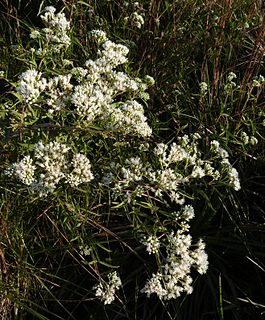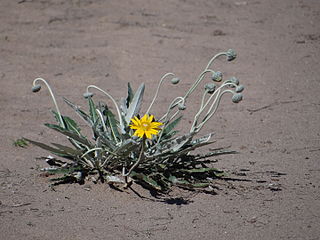
Psidium is a genus of trees and shrubs in the family Myrtaceae. It is native to warmer parts of the Western Hemisphere.

Myrciaria is a genus of large shrubs and small trees described as a genus in 1856. It is native to Central and South America, Mexico, and the West Indies, with many of the species endemic to Brazil. Common names include hivapuru, sabará, and ybapuru.

Trixis is a genus of shrubs in the aster family, Asteraceae, native to North and South America including the West Indies.

Campomanesia is a genus in the family Myrtaceae described as a genus in 1794. It is native to South America and Trinidad.

Plinia is a genus of flowering plants in the myrtle family, Myrtaceae described by Linnaeus in 1753. It is native to Central and South America as well as the West Indies.

Morrenia odorata, the latexplant or strangler vine, is a plant in the family Apocynaceae, which is native to South America. This plant is cited in Flora Brasiliensis by Carl Friedrich Philipp von Martius. The species is widely cultivated as an ornamental.

Blepharocalyx is a genus of plant in family Myrtaceae first described as a genus in 1854. It is native to South America and the West Indies.
- Blepharocalyx cruckshanksii(Hook. & Arn.) Nied. - Chile
- Blepharocalyx eggersii(Kiaerskou) L.R.Landrum - Lesser Antilles, Venezuela, Guyana, Peru, Brazil
- Blepharocalyx myriophyllus Mattos - Minas Gerais
- Blepharocalyx salicifolius(Kunth.) O.Berg - Brazil, Bolivia, Peru, Ecuador, Paraguay, Uruguay, N Argentina

Nassauvia is a genus of flowering plants in the Nassauvia tribe within the sunflower family. It is native to Argentina, Bolivia, Chile and the Falkland Islands.

Araujia is a small genus of perennial vines in the dogbane family first described as a genus in 1817. The group is native to South America.
- Araujia angustifolia(Hook. & Arn.) Steud. - Brazil, Paraguay, Uruguay, NE Argentina
- Araujia graveolens(Lindl.) Mast. - Brazil
- Araujia herzogii(Schltr.) Fontella & Goyder - Bolivia
- Araujia hortorumE.Fourn. - Brazil, Paraguay, Uruguay, NE Argentina
- Araujia megapotamica(Spreng.) G.Don - Brazil, Uruguay, NE Argentina
- Araujia plumosaSchltr. - Brazil, Paraguay, Bolivia, NW Argentina
- Araujia sericiferaBrot. - white bladderflower, cruel vine - Peru, Brazil; naturalized in parts of South Africa + United States
- Araujia stuckertiana(Kurtz ex Heger) Fontella & Goyder - Cordoba in Argentina
- Araujia subhastataE.Fourn. - Brazil

Austroeupatorium is a genus of plants native primarily to South America, including herbaceous perennials and shrubs. The native range is focused on eastern South America and extends as far north as Panama and Trinidad and as far west as Bolivia.

Hysterionica is a genus of flowering plants in the family Asteraceae.

Trichocline is a genus of Australian and South American plants in the gerbera tribe within the daisy family. It consists of one species from Australia (T. spathulata) and twenty-three from South America.
Graphistylis is a genus of Brazilian flowering plants in the daisy family.
Holocheilus is a genus of flowering plants in the daisy family.

Gochnatia polymorpha, the candeia or cambará, is a South American tree species in the sunflower family, native to Brazil, Bolivia, and Paraguay.

Fischeria is a plant genus in the family Apocynaceae, first described as a genus in 1813. It is native to South America, Central America, southern Mexico, and the West Indies.
Tassadia is a genus of plants in the family Apocynaceae, first described as a genus in 1844. It is native primarily to South America, with one species extending north into Central America, S Mexico, and Trinidad.

Siphoneugena is a genus of the botanical family Myrtaceae, first described as a genus in 1856. It is native to Central and South America as well as the West Indies.
Chevreulia is a genus of plants in the family Asteraceae, described as a genus in 1817.

Moquiniastrum is a genus of flowering plants belonging to the family Asteraceae.















